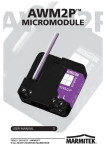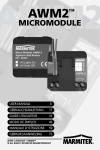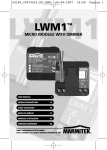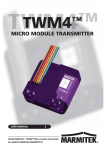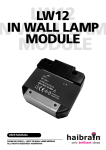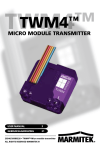Download Marmitek MultiMedia Remote User manual
Transcript
LWM1P LWM1P ™ MICRO MODULE WITH DIMMER USER MANUAL 3 LWM1P™ MICROMODULE WITH DIMMER 20259 / 20080521 © ALL RIGHTS RESERVED HAIBRAIN ® MicroModule LWM1P 6 5 4 3 ENGLISH 1.Phase clamp (230V) 2.Load clamp 3.Neutral clamps 4.Indicator light (LED) 5.Set up button 6.Wire connections to wall switch 2 2 1 NEDERLANDS 1.Fase aansluiting (230V) 2.Aansluiting voor belasting 3.Nullklemmen 4.LED indicator 5.Programmeerknopje 6.Aansluitdraden voor schakelaar © HAIBRAIN SAFETY WARNINGS • The wiring of your electrical installation is live (230 V) and extremely dangerous. Never connect the module when plugged into the mains. Always turn off the main switch before starting the installation. • This product is for professional use and should be installed by a certified installer. • To prevent short circuits, this product should only be used inside and only in dry spaces. Do not expose the components to rain or moisture. Do not use the product close to a bath, swimming pool etc. • Do not expose the components of your systems to extremely high temperatures or bright light sources. • Do not open the product: the device contains live parts. The product should only be repaired or serviced by a qualified repairman. • In case of improper usage or if you have opened, altered and repaired the product yourself, all guarantees expire. Haibrain does not accept responsibility in the case of improper usage of the product or when the product is used for purposes other than specified. Haibrain does not accept responsibility for additional damage other than covered by the legal product responsibility. • This product is not a toy. Keep out of reach of children. • Automatic switching devices provide comfort, but can also be dangerous. They can surprise people or can ignite clothing hanging over an electric heat source. Please be careful and take appropriate measures to avoid accidents. LWM1PTM 3 ENGLISH LWM1P™ BUILT-IN DIMMER MODULE TABLE OF CONTENTS HOW DOES HAIBRAIN X-10 WORK? ADRESSES SIGNAL RANGE INSTRUCTIONS FOR USE INTRODUCTION FUNCTIONS MOUNTING INSTRUCTIONS PROGRAMMING USAGE OF THE MICROMODULES IN A 3 PHASE INSTALLATION TESTING THE FUSE LOW VOLTAGE HALOGEN LIGHTING FREQENTLY ASKED QUESTIONS TECHNICAL DATA 4 5 5 7 7 7 10 11 13 13 14 15 17 HOW DOES HAIBRAIN X-10 WORK? Haibrain X-10 components use the existing mains wiring to communicate (using Haibrain X-10 signals). You can build a complete system using the three different kind of components of the Haibrain X-10 System: These components will receive Haibrain X-10 signals and will switch or dim the attached lamp or appliance. These components will transmit Haibrain X2. Controllers: 10 signals and thus will control the Modules. 3. Transmitters: Wireless components like remotes. The signals of these components will be received by a controller with transceiver functionality (IRRF 7243, TM13, CM15Pro or console of a Haibrain Security System). The Transceiver will translate the signals into Haibrain X-10 signals on the power line. 1. Modules: 4 © HAIBRAIN SIGNAL RANGE Range of Haibrain X-10 signals over the Power Line and how to increase the range. The Haibrain X-10 System is based on power line communication. The range of the Haibrain X-10 signals very much depends on the local circumstances. On average the range is a cable length of 80 meters. If you have difficulties with the range of your Haibrain X-10 signals, please pay attention to the following facts: 1. When several phases are used in the house, it can be necessary to couple these phases for Haibrain X-10 signals. You can couple them with the use of a CAT 3000 active 3 phase coupler/repeater (Art.No. 09304) and it is required if wall outlets and lighting points are actually divided into several phases (several groups is no problem for the Haibrain X-10 signal). 2. It is possible that Haibrain X-10 signals are attenuated by devices and lights which are connected to the power line. In a normal home situation this effect is negligible (the Haibrain X-10 system is using active gain control to eliminate the effects). However, it is possible that a particular device in your house is attenuating the signals so much that the range of Haibrain X-10 signals is decreased significantly. When you have range problems, it is wise to try to locate the device which is attenuating the signals simply by unplugging devices LWM1PTM 5 ENGLISH ADRESSES Up to a maximum of 256 different addresses can be preset. These are subdivided into a so-called HouseCode (A to P incl.) and a UnitCode (1 to 16 incl.). The HouseCode can also be set on the controllers, so that the controllers and modules become part of the same system. The address can be set either using code dials or by pressing buttons, depending on the type of module. The Haibrain X-10 System uses standard commands, which control all units with the same HouseCode at the same time (e.g. all lights on, all off, etc.). from the power line, and testing the differences in range for your Haibrain system. When e.g. your conclusion is that e.g. your computer monitor is attenuating the signal, you can use a FM10 Plug-in Filter between the power line and the monitor to eliminate the effects. Known devices which can cause attenuation are: PC Monitors PCs with heavy internal power supplies Old Televisions Copiers Fluorescent Lights Gas Discharge Lamps (Energy Saving Lamps) 3. Some (old) devices are able to disturb the signal by transmitting noise on the power line. Because the Haibrain X-10 signals are transmitted on 120 kHz, only noise on or near this frequency will have influence on the range. When you use a FM10 Filter to connect this device to the power line, the noise will be filtered. 4. The Haibrain X-10 protocol has several mechanism to avoid modules to be switched on or off by other sources than your Haibrain X-10 Controllers. However, it is possible that the Haibrain X-10 signals are disturbed by e.g. baby phones which are in TALK mode (continuous transmission). When these kind of signals are present on the power line it is possible that the Haibrain X-10 signals will not come through. 5. The mains do not stop at the front door of your home. Everything that is attached to mains nearby your home can have influence on Haibrain X-10 signals (e.g. heavy machinery). If you think that your system is influenced by devices out of your house, it is advisable to install FD10 Phase Coupler/Filter on each phase entering the house. These filters will block signals coming into or going out of your house, but will also match the impedance for the mains. The FD10’s will not only filter but will also couple the phases (please see 1). To couple the phases use a CAT 3000, see point 1 above. 6 © HAIBRAIN INTRODUCTION Congratulations on the purchase of the Haibrain X-10 built-in dimmer module LWM1P. • Because of its extremely small proportions, the module can be built in behind wall switches and wall outlets (minimal backbox depth 40mm, advice 50mm). The module is also ideally suited to build in light armatures and for installation in small spaces in for instance lowered ceilings. • Multi-purpose: fully free choice in brand, colour and model switch material. With the built-in dimmer you can switch and dim 230V light bulbs, 230V halogen lighting and low voltage halogen lighting with electronic transformer suitable for phaseingate up to 120 Watt. • The module can be controlled by Momentary switches connected to the module or at a distance, making use of the Haibrain X-10 (plc) signal through the power line. • In case of a voltage cut-off, the module will save the reading prior to the cut-off. (dim level/off). Please note: due to heat generation, apply no more than one module per flush socket / central socket! FUNCTIONS • Local control via the switch attached to the module or remote control using Haibrain X-10. • Built-in dimmer, 120W. • Two-way X-10: transmits the set dimmer level to other LWM1P, LD11, LW12 and LW11 modules (set to the same HouseCode and UnitCode). • Softstart and softdim. • Memory function for last dimmer setting. • Responds to ON, OFF, DIM, BRIGHT and extended X-10 (dimmer setting originates from other LWM1P modules). LWM1PTM 7 ENGLISH INSTRUCTIONS FOR USE - LWM1P™ BUILT-IN DIMMER MODULE • Can respond to All Lights On and All Units Off (configuration). • Choice between 1-way momentary switch or 2-way momentary switch. Explanation about connecting switches: Note: In the standard setting the LWM1P module assumes a ‘2-way momentary switch’ has been connected. “1-way momentary switch”: Push to make switch without intermediate setting. 1 short press is ON, keeping the button pressed is DIM, second press is OFF. When connecting this type of switch, the white and purple wires are connected to the impulse contact of the switch. The phasewire (L) is connected to the P or L contact of the switch. Colour coding for the 1-way momentary switch: Connect White and Purple: alternating ON/BRIGHTER and OFF/DIM. PROG. LWM1P White Purple N L Brown(L) Black Blue(N) P Brown (L) 8 © HAIBRAIN ENGLISH “2-way momentary switch” Push to make switch with intermediate setting. Both the top and bottom part of the switch can be pressed. Short press top is ON, long press top is BRIGHTER. Short press bottom is OFF, long press bottom is DIM. When connecting this type of switch, the purple wire is connected to the contact for the top part of the switch (ON/BRIGHTER) and the white wire to the contact for the bottom part of the switch (OFF/DIM). The phase wire is connected to the common P or L contact of the switch. PROG. LWM1P White Purple N L Brown (L) Black Blue (N) P Brown (L) Colour coding for the 2-way momentary switch: Purple: ON/BRIGHTER White: OFF/DIM LWM1PTM 9 MOUNTING INSTRUCTIONS WARNING! ALWAYS SWITCH OFF THE MAIN MASTER SWITCH BEFORE INSTALLING THE MICROMODULE. To install the MicroModule LWM1P the following wiring is required at the module installation point. Phase 230V Neutral Load. This wire runs directly to the load. • • • • • • • • Take the wall switch, if present, out of the wall outlet. Disconnect all wires from the switch. Pull an additional N-wire in case this one is missing. Connect the phase, neutral and load wire to the terminals of the MicroModule LWM1P. Connect the thin wires of the built-in module and phase to the wall switch. See “Explanation about connecting switches” for more information. Position the MicroModule against the back wall of the wall outlet behind all the wires. You are now able to program the MicroModule. For more information see chapter “Programming”. Install the wall switch at its original place after the MicroModule is programmed. 10 © HAIBRAIN Activate the setup procedure. The following steps have to be taken to start the setup procedure for programming the MicroModule: • Press the setup (prog.) button for at least 3 seconds. The LED should stay on after releasing the setup button. • Warning! The MicroModule will leave the setup mode if it doesn’t receive any commands within 60 seconds. Exit setup mode • Press the setup button once shortly. You can also wait for at least 60 seconds so that the MicroModule will exit the setup mode automatically. P PROG. LWM1P N L PROG. Activate or exit the setup mode. LWM1PTM 11 ENGLISH PROGRAMMING WARNING: DO NOT FORGET TO TURN ON THE MAIN MASTER SWITCH PRIOR TO PROGRAMMING. Programming the X10 address and the various options. The chart below shows the various possibilities to program the MicroModule LWM1P. Factory defaults Programmable Command Light blinks Address A1 Address A2 .. P16 2x Address 2x Doesn’t respond to “All Lights On” Responds to “All lights On” 2x All Lights On 6x Doesn’t respond to “All Off” Responds to “All Off” 2x All Off 8x Connected switch is a 2-way momentary switch Connected switch is a 1-way momentary switch 2x Bright 12x For programming the Haibrain X10 address and options you will be able to use any Haibrain X10 controller or remote control, apart from the CM11 computer interface. For the following explanation we used a Haibrain 8-in-1 remote control to program the preferred settings (when you use an RF remote control like the Haibrain 8-in-1, then a TM13 Plug-in Transceiver is required to convert the RF signals to the X10 commands through the power line). Sample 1. Program the Haibrain X10 address E4: • Setup your remote control (see manual 8-in-1) and the TM13 transceiver to house code E. • Start with the MicroModule in setup mode. • Press the Haibrain X10 button (marked with the symbol of a house) of the 8-in-1 remote control and then press button 4. • Press the “ON” button 2x (= channel+). • The MicroModule responds by blinking the LED twice. • The address E4 is programmed. • If you wish to program more options, you have to make sure the module remains in setup mode. Sample 2. Program the function “All Units Off”. • Make sure you program the required Haibrain X10 address first!! (e.g. E4). 12 © HAIBRAIN NOTES: • When you program the MicroModule, always program the address first the optional functions second. • If the MicroModule receives a new address during setup mode, the optional functions will be automatically reset to the default settings. USAGE OF THE MICROMODULES IN A 3 PHASE INSTALLATION The X10 transmitters of the MicroModules transmit the command only once for use in the phase of which they are connected. When you want to receive the commands on your other phases as well, you will need to install the CAT3000 phase coupler/repeater. The FD10 phase coupling filters can be used as netfilters, but not as phase couplers in combination with the LWM1P. TESTING THE FUSE Test the performance of the fuse (type TR5-1, 6 AT). Disconnect the LWM1P from the load (lamp, transformer). Then measure the voltage on the output clamp with a voltmeter. If there is no voltage, the fuse is defective. NOTE: In case of a melted fuse the programming LED still blinks. LWM1PTM 13 ENGLISH • Make sure the module remains in setup mode. • Press button marked with “All Off” 2x (= mute). • The MicroModule responds by blinking the LED 8x. Replacing the fuse after melt-through. LWM1P LWM1P Replacing the fuse is possible without opening the module! (if the module has been opened the guarantee no longer applies). Remove the film above the fuse and then pull the fuse out of the module with pointed pliers. Replace the fuse with a fuse of one of the following types (with the application of other types the guarantee no longer applies): Supplier dimmer fuse Description Order number supplier Littelfuse LT-5 ALg 0663.01.6 Bussman ETF Radial Lead Micro Fuse BK ETF1.6 ELU Sub miniature fuse links 166050-1,6AT Wickmann Subminiatur fuse No 372.TR5 372-1160-041 Bel fuse Time Lag Radial Lead Micro Fuse MTR1,6 short leads NEVER CONNECT A WOUND VOLTAGE TRANSFORMER TO THE LWM1P WHILE THE VOLTAGE IS SWITCHED ON. THE FUSE CAN MELT AS A RESULT. LOW VOLTAGE HALOGEN LIGHTING The LWM1P can only be used in combination with the electronic transformer suitable for leading-edge phase dimmers. The LWM1P cannot be coupled to transformers suitable for trailingedge phase dimmers. Coupling it to such a transformer will cause a humming sound and damage the LWM1P. The right to guarantee will also expire as a result. 14 © HAIBRAIN My modules will not respond to my controller. Make sure that the House Code on all Modules and Controllers are set to the same House Code (A .. P). My modules will not react to my remote / sensor. When you use a remote or sensor, you should have at least one TM13 Transceiver or Haibrain Security Console installed in your house. These components will translate the radio signals to the Haibrain X-10 signal on the power line. Only one Transceiver should be installed for all remotes and sensors set to the same House Code. Am I able to increase the range of my remotes by using more Transceivers? Yes, you can use more than one TM13 Transceiver in your home when the range of your remotes is not sufficient. The TM13 is using so called collision detection to prevent signals to be disturbed when more than one TM13 is transmitting. TM13’s will wait for a quite power line before transmitting their data. To prevent your Haibrain X-10 System to become slow or to prevent dimming from becoming less smooth, make sure that the TM13 units are placed as far away from each other as possible. The module suddenly starts to blink for a short time. Electronic dimmers, such as the LWM1P, make use of cutting in or cutting off the sine in order to transform voltage. In an unstable mains system, or as a consequence of short low frequency pulses, the shape of the sine can be disrupted, resulting in light variations. This phenomenon does not harm the modules. LWM1PTM 15 ENGLISH FREQUENTLY ASKED QUESTIONS What is the reason for modules to switch on/off spontaneously? It is possible that a Haibrain X-10 System is installed at one of your neighbours using the same House Code. To solve this problem try to change the House Code of your system, or have FD10 Phase Coupler/Filter installed at your incoming mains. Programming the LWM1P through the IRRF7243 is not working. If you wish to program the module with the help of a remote control and the IRRF7243 you need to follow a slightly different procedure (Example: setting UnitCode 2 with an 8in1 Multimedia remote control): • push the “house” on the remote control. • push button [2]. • give an [on] command 2 times. • close off with button [2]. The last action is only necessary when using the IRRF7243. When using a TM13 or an alarm central, the address will already be altered with the second on- command. Can I connect a two-way switch to the LWM1P? No, you can only connect a Momentary switch to the LWM1P. For two-way switches you can use the AWM2P although you cannot dim with this one. Can I use several switches to control the LWM1P? Yes, you can connect more switches parallel to the first switch. They do have to be all 1-way momentary switches or all 2-way momentary switches. My LWM1P is getting warm. Because of the micromodules’ small size, they become warmer than the ‘larger’ Haibrain Home Automation components. However, this is nothing to worry about. Do you still have questions? Please check out http://www.haibrain.com.for more information. 16 © HAIBRAIN X-10 Key codes: X-10 transmisson: Switch use: Connection reach: Fuse: Environment temperature: Dimensions: Built-in depth: 230V ±10% - 50Hz. <30 mA capacitive 120W/230V light bulbs. 100W Low voltage halogen lighting with wound voltage transformer. 120W Low voltage halogen lighting with electronic voltage transformer. (recommended voltage transformer: Osram HTM series. If you use other voltage transformers, we advise you to test the combination before building in the system). Softstart/Softdim. Memory reading for dim level All units Off, All Lights On, On, Off, Dim, Bright, Extended Code 1 type 3, Pre-Set Dim, Status Request. 1 pulse on 0° and 180°. 1 or 2 way momentary switch. Till 2.5 mm2 Radial lead micro fuse, 1.6AT, 250V. -10°C to +35°C (operation) -20°C to +70°C (storage). 46x46x16mm. 40 mm (minimum), 50 mm (advised) Environmental Information for Customers in the European Union European Directive 2002/96/EC requires that the equipment bearing this symbol on the product and/or its packaging must not be disposed of with unsorted municipal waste. The symbol indicates that this product should be disposed of separately from regular household waste streams. It is your responsibility to dispose of this and other electric and electronic equipment via designated collection facilities appointed by the government or local authorities. Correct disposal and recycling will help prevent potential negative consequences to the environment and human health. For more detailed information about the disposal of your old equipment, please contact your local authorities, waste disposal service, or the shop where you purchased the product. LWM1PTM 17 ENGLISH TECHNICAL DATA Power: Supply current: Capacity:



















